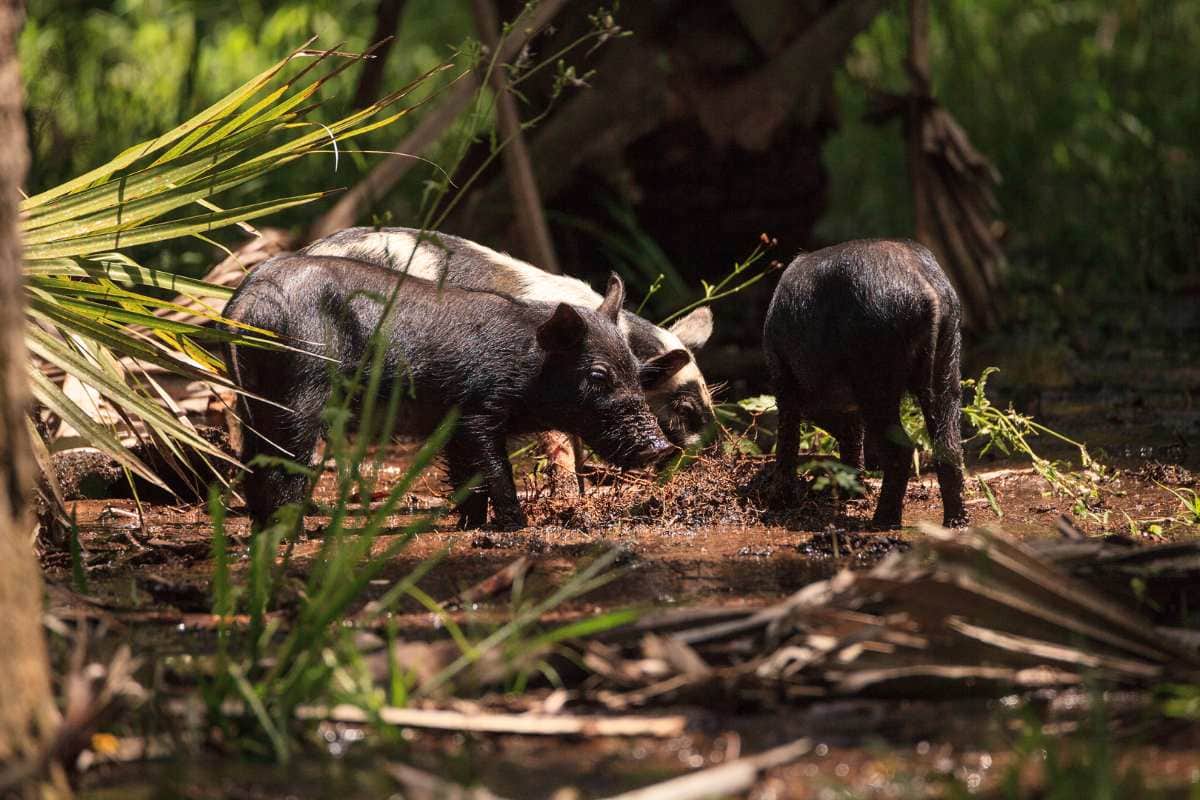Across much of the southern United States, feral hogs have become extremely prevalent, dotting the rural landscape from one end to the next. With each passing year, the home range of the feral hog continues to expand, covering an ever-larger swath of the country.
In many areas, spotting a handful of hogs on any given trip to the field is more of an expectation rather than a possibility.
However, this rate of population growth has caused a certain level of concern among hunters, who question the impact that such expansion will have upon the whitetail deer across much of its historic range.
Primarily, many questions whether or not deer will feed with hogs and how potential deer/hog interaction will affect their hunting efforts.
Contents (Jump to Topic)
ToggleExplosive Population Growth
Feral hog populations have exploded over the past several decades, growing to unprecedented levels. This has proven especially concerning, considering that feral hogs are regarded as non-native pests in most areas.
Hogs of this type are not one and the same as native boar species, often found in countries such as Russia.
Quite the contrary, today’s feral hogs are direct descendants of domestic swine that were released into the present-day United States in the 16th century.
The first of these domestic hogs were believed to have been released in the 16th century by colonists arriving in the “New World.”
Releases of this type were seen as a means of guaranteeing a sustainable food source for future colonists. Efforts of this nature were believed to have initially taken place in the peninsula of present-day Florida.
Over the years, feral hog numbers have swelled beyond all comprehension. This growth has been spurred on by a general lack of natural predators across much of the American landscape and rapid reproduction.
At the current moment, feral hogs can be found across the greater portion of the Southern United States, isolated segments of the northern United States, and parts of Canada.
The feral hogs’ expansion shows little sign of slowing in the near future, as few means of population control have proved effective.
Deer Vs. Hog Interaction
As a result of the above-mentioned population growth, the home ranges of the Whitetail Deer and feral hog now overlap in many areas. For this reason, deer and feral hogs are forced to interact to a certain extent.
For many hunters, this is a great point of concern, leaving some to wonder if their deer hunting efforts will suffer.
In this case, such concern has a certain degree of merit. Deer tend to be somewhat skittish around hogs, largely limiting interaction in many areas.
Feral hogs can be quite aggressive under the right circumstances, often causing deer to give them a large berth when possible.
However, the exact effect that feral hogs have on the deer in a given area is far from an exact science. Some deer seem far more adapted to interaction with hogs than others.
This tends to be the case in states such as Texas and Florida, where the feral hog population are at an all-time high.
Even in these areas, one seldom observes the two species feeding side-by-side, though they might be spotted in the same fields.
On the other side of the coin, deer in other areas of the country can often be seen evacuating fields and woodlots whenever feral hogs approach.
In any event, it seems that deer are less likely to hold their ground as hog numbers increase. While one or two hogs seldom deter deer in good numbers, a sizable drove of hogs is likely to cause deer to go elsewhere.
The Bigger Problem
There is a far bigger problem that arises from the growth of feral hog numbers than that which centers around deer and hog interaction.
Hogs feed on anything and everything imaginable, almost indiscriminately, quickly ravaging traditional food sources of the Whitetail deer.
From food plots to mast crops such as acorns, droves of hogs have been known to deplete one food source after another in a matter of weeks. This, in turn, leave an area mostly void of the sustenance that deer rely upon for survival.
Simply put, deer cannot compete with feral hogs for a specific food source to any significant degree of success.
This issue is perhaps the greatest factor behind dwindling deer sightings in areas where hogs have laid claim.
Rather than competing for a largely depleted food source, deer adapt by shifting their home ranges to encompass areas with fewer hogs and a greater supply of forage.
This is an ongoing concern for hunters and property managers alike, further complicated by the fact that long-term feral hog eradication is largely impractical.
To date, the best possible solution to the matter of feral hog overpopulation centers around a mixture between proactive hunting and trapping efforts, along with sound guidance from a certified state wildlife biologist.






